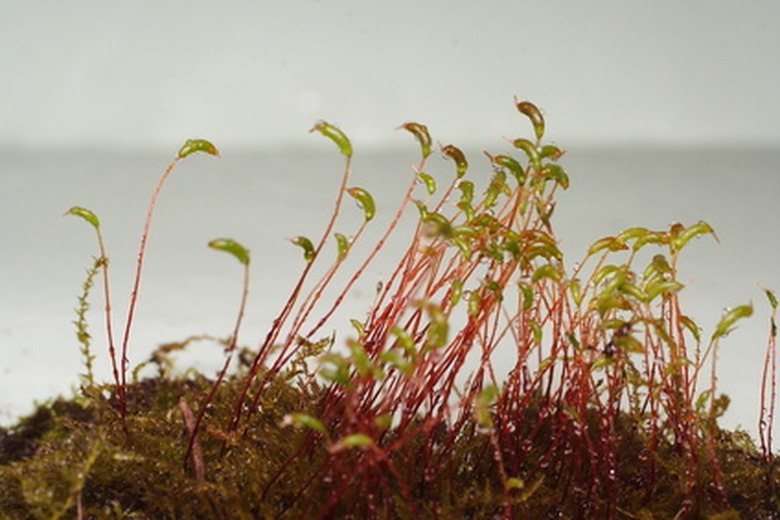Life Cycle Of A Nonvascular Plant
Nonvascular plants, or types of plants that lack the tissue structure to transport water and nutrients, are typified by plants such as mosses, liverworts and hornworts. Because these plants cannot move water and nutrients through their leaves, they usually are very low-growing and found in consistently moist environments. Water is also necessary for the reproductive process of these plants, as it facilitates the movement of sperm to the egg for fertilization.
Definitions
The cells of most organisms, including plants, are diploid, meaning each cell contains two copies of its particular set of chromosomes. Reproductive cells, or sex cells, of organisms are haploid (n), meaning they contain only one copy of the chromosome set. Fertilization occurs when two haploid cells fuse to create a single diploid (2n) cell with a full set of chromosomes. Haploid plant sex cells are known as gametes, and diploid plant non-sex cells are known as zygotes. Nonvascular plants also have structures known as gametophytes and sporophytes: gametophytes produce gametes via the cell division process known as mitosis, and sporophytes that grow on the zygote eventually divide via meiosis, a process that produces haploid spores.
- Nonvascular plants, or types of plants that lack the tissue structure to transport water and nutrients, are typified by plants such as mosses, liverworts and hornworts.
- Reproductive cells, or sex cells, of organisms are haploid (n), meaning they contain only one copy of the chromosome set.
Alternation of Generations
All plants are characterized by a genetic alternation of generations, or a two-stage life cycle that alternates between chromosomal stages. The dominant stage in nonvascular plants is the haploid stage, punctuated by a shorter reproductive period during which the plant's male and female sex cells fuse to form diploid cells. After undergoing meiosis to become haploid spore cells, these spores are dispersed to begin the next generation.
Spore Germination and Early Growth
In both mosses and liverworts, haploid spores produced by the previous generation germinate to form a young plant with a thin stem and root-like fibers that anchor the plant to the ground. As this gametophyte plant grows by non-sexual cell division, it eventually develops separate reproductive structures at the top of the plant, each of which produces either male sperm or female eggs. The male structure is known as the antheridium, while the female structure is known as the archegonium.
Fertilization and Spore Dispersal
Haploid sperm cells produced by nonvascular plants are motile, meaning they are equipped with tails and must swim through liquid to reach a female egg to fertilize. After sperm cells in the antheridium are mature, they swim to reach eggs in the archegonium and combine to form a diploid zygote. This zygote grows on the mother plant and is dependent upon it for water and nutrients. The zygote produces a capsule that contains another generation of diploid cells that undergo meiosis, to become haploid, after which the capsule ruptures so spore cells can be dispersed from the parent plant.
- All plants are characterized by a genetic alternation of generations, or a two-stage life cycle that alternates between chromosomal stages.
- The zygote produces a capsule that contains another generation of diploid cells that undergo meiosis, to become haploid, after which the capsule ruptures so spore cells can be dispersed from the parent plant.
Other Methods of Reproduction
Though liverworts produce sexually as described, they also reproduce asexually as well. The main method of reproduction in liverworts generally is via fragmentation, where a piece of the plant breaks off and anchors to become a separate, independent plant. Liverworts also accomplish asexual reproduction through portions of tissue called gemmae, which grow in small cups on the liverwort called gemmae cups. When rainwater reaches the gemmae cup, gemmae are dispersed outward from the parent plant. Those gemmae that land in suitable locations develop into new liverwort plants.
